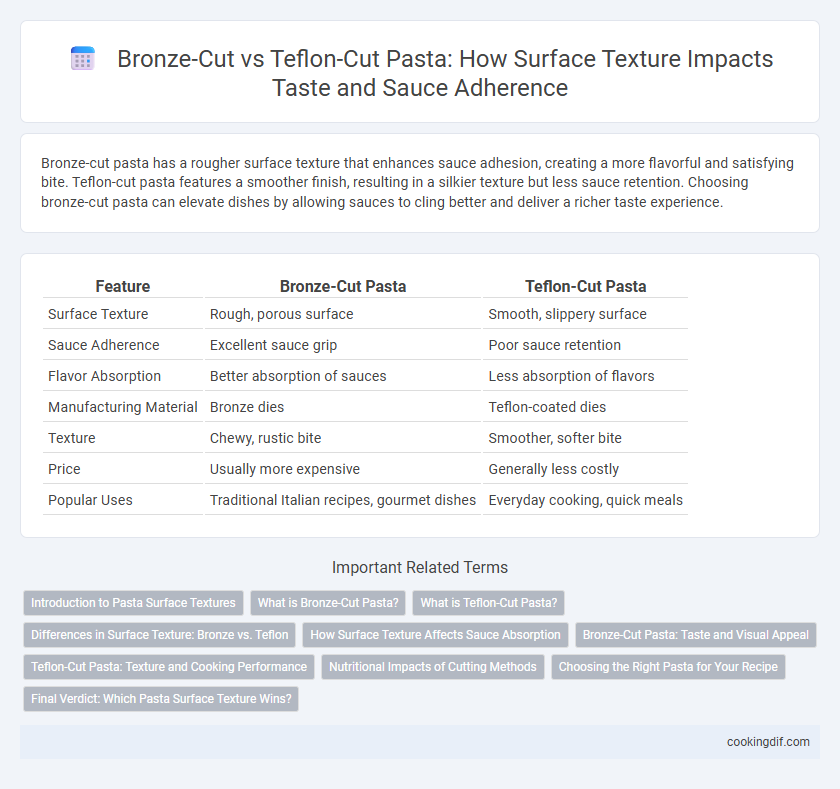Bronze-cut pasta has a rougher surface texture that enhances sauce adhesion, creating a more flavorful and satisfying bite. Teflon-cut pasta features a smoother finish, resulting in a silkier texture but less sauce retention. Choosing bronze-cut pasta can elevate dishes by allowing sauces to cling better and deliver a richer taste experience.
Table of Comparison
| Feature | Bronze-Cut Pasta | Teflon-Cut Pasta |
|---|---|---|
| Surface Texture | Rough, porous surface | Smooth, slippery surface |
| Sauce Adherence | Excellent sauce grip | Poor sauce retention |
| Flavor Absorption | Better absorption of sauces | Less absorption of flavors |
| Manufacturing Material | Bronze dies | Teflon-coated dies |
| Texture | Chewy, rustic bite | Smoother, softer bite |
| Price | Usually more expensive | Generally less costly |
| Popular Uses | Traditional Italian recipes, gourmet dishes | Everyday cooking, quick meals |
Introduction to Pasta Surface Textures
Bronze-cut pasta features rough, porous surfaces that allow sauces to cling better, enhancing flavor absorption and mouthfeel. Teflon-cut pasta, by contrast, has a smooth surface that results in a firmer texture but less sauce retention. The choice between bronze-cut and Teflon-cut impacts the overall dining experience by influencing how pasta interacts with dressings and ingredients.
What is Bronze-Cut Pasta?
Bronze-cut pasta is made by extruding dough through bronze dies, creating a rougher, porous surface that better holds sauces and enhances flavor absorption. This traditional method results in a more textured pasta compared to Teflon-cut pasta, which uses smoother non-stick dies producing a slicker surface. The rough texture of bronze-cut pasta is favored in authentic Italian cooking for its ability to capture and cling to rich, hearty sauces.
What is Teflon-Cut Pasta?
Teflon-cut pasta is created using dies coated with Teflon, producing a smooth, non-porous surface that results in a slick texture on the cooked pasta. This technique contrasts with bronze-cut pasta, which has a rougher texture due to the porous nature of bronze dies, allowing sauce to cling better. The smooth surface of Teflon-cut pasta makes it ideal for lighter or oil-based sauces that complement its slippery texture.
Differences in Surface Texture: Bronze vs. Teflon
Bronze-cut pasta features a rough, porous surface that clings better to sauces, enhancing flavor absorption and providing a traditional texture preferred in artisanal pasta. Teflon-cut pasta, by contrast, has a smooth, slick finish resulting in a less adhesive surface that offers a softer mouthfeel but reduced sauce retention. The distinct surface texture differences directly affect cooking outcomes and culinary applications, with bronze-cut pasta favored for robust, thick sauces and Teflon-cut suited for lighter, delicate preparations.
How Surface Texture Affects Sauce Absorption
Bronze-cut pasta features a rougher, more porous surface that enhances sauce adhesion and absorption, creating a fuller flavor experience. Teflon-cut pasta, in contrast, has a smoother texture that can cause sauces to slide off, reducing the overall taste integration. Chefs often prefer bronze-cut pasta for robust sauces like ragu or pesto to maximize the sauce's cling and depth.
Bronze-Cut Pasta: Taste and Visual Appeal
Bronze-cut pasta features a rough, porous surface that better holds sauces, enhancing flavor absorption and creating a more authentic taste experience. This texture also imparts a rustic, artisanal appearance with jagged edges, distinguishing it visually from the smooth surface of Teflon-cut pasta. The traditional bronze-cut method contributes to a more satisfying bite and preferred mouthfeel, making it a favorite among gourmet chefs and pasta enthusiasts.
Teflon-Cut Pasta: Texture and Cooking Performance
Teflon-cut pasta features a smooth surface texture that enhances a silky mouthfeel but offers less sauce adherence compared to bronze-cut varieties. The non-stick properties of Teflon molds result in a uniform shape and quicker cooking times, making Teflon-cut pasta ideal for delicate dishes. This production method prioritizes consistency and efficient cooking, appealing to consumers seeking a refined texture and ease of preparation.
Nutritional Impacts of Cutting Methods
Bronze-cut pasta features a rougher surface texture that enhances sauce adhesion, potentially improving flavor absorption and nutrient intake during digestion. In contrast, Teflon-cut pasta has a smoother surface that may result in less sauce retention, possibly diminishing the bioavailability of fat-soluble vitamins and antioxidants found in accompanying sauces. The cutting method influences not only texture but also the interaction between pasta and nutrient-rich sauces, impacting overall nutritional benefits.
Choosing the Right Pasta for Your Recipe
Bronze-cut pasta features a rougher texture that helps sauces cling better, making it ideal for hearty, chunky recipes like ragu or vegetable sauces. Teflon-cut pasta has a smoother surface, which works well with light, delicate sauces or simple olive oil dressings to prevent overpowering the pasta's flavor. Selecting the right pasta surface texture enhances the overall dish by matching pasta to sauce consistency and desired mouthfeel.
Final Verdict: Which Pasta Surface Texture Wins?
Bronze-cut pasta features a rough, porous surface that better retains sauces, enhancing flavor absorption and creating an authentic, artisanal texture preferred by chefs. Teflon-cut pasta offers a smoother, uniform finish that cooks evenly but often lacks the robust sauce adherence of bronze-cut varieties. For pasta lovers seeking exceptional sauce retention and a traditional texture, bronze-cut pasta ultimately delivers the superior culinary experience.
bronze-cut vs Teflon-cut for pasta surface texture Infographic

 cookingdif.com
cookingdif.com